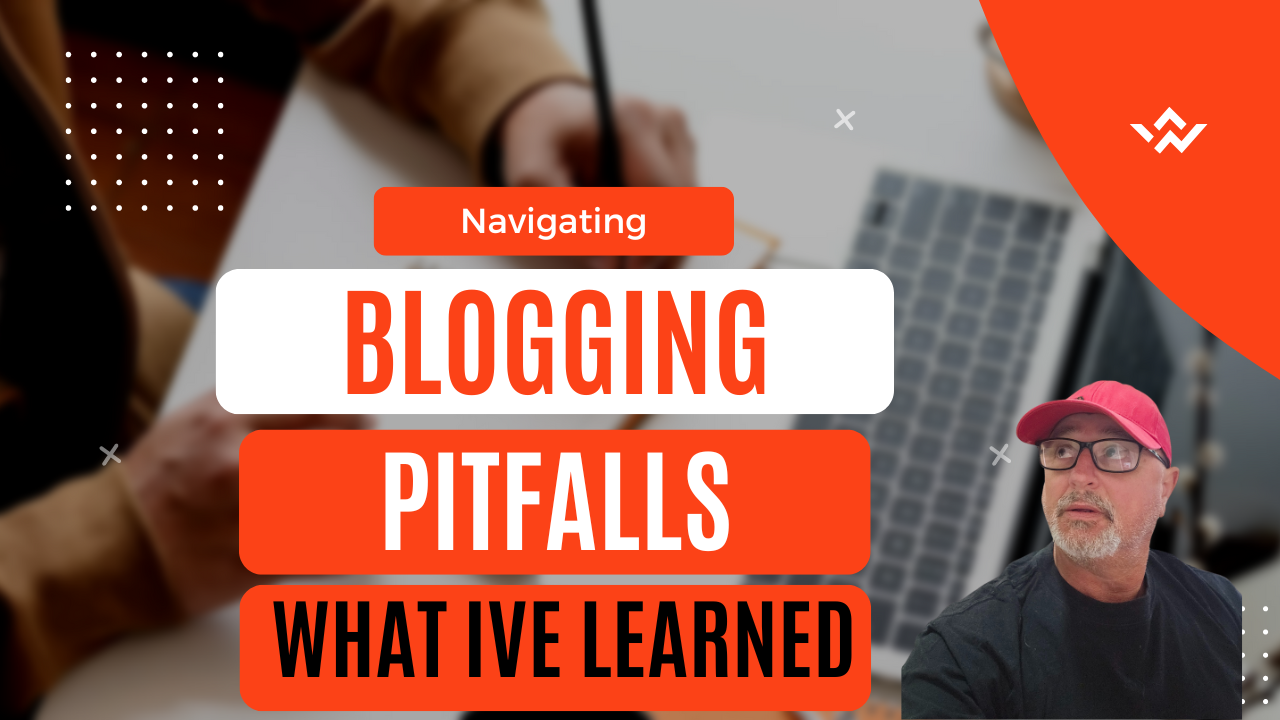I’ve been blogging for almost a decade, and believe me, I still have blogging pitfalls! Through trial and error, I’ve learned a great deal about the dos and don’ts of this dynamic platform. I’m going to share with you the stumbles and successes I’ve navigated along the way.
You’re going to find out about the common traps many bloggers fall into, including myself. And I’m not just talking about small slip-ups. I’m talking about those major faux pas that can divert your blogging journey significantly off course, sometimes without you even realizing it.
This isn’t just about telling you what not to do. It’s also about sharing the rich insights that come from those blunders. Each hiccup has pushed me to refine my strategy, sharpen my skills, and come back stronger and more informed than before. That’s the beauty of this path; it’s paved with lessons learned, and each one is a stepping stone to better blogging.
Now, let’s peel back the layers of this experience and delve into the first mistake that many of us make when starting our blogging journey: ‘Underestimating the Power of a Niche’. This lesson took me some time to grasp, but when I did, it changed the game for my content creation and audience engagement.
Mistake #1 – Underestimating the Power of a Niche
I’ll be the first to admit, when I started blogging, I wanted to tackle every topic under the sun. From travel diaries to tech reviews, I was scattered, and so was my audience. It was a classic rookie move, and one I’m not shy to talk about. I was learning the hard way that when you’re speaking to everyone, you’re effectively speaking to no one.
The turning point came when I noticed some posts resonated more than others. Those were the posts where I honed in on a specific interest, where my passion and knowledge shined. That’s when the light bulb went off – niche is king. By zeroing in on a focused area, I could increase the appeal to a specific audience and become the go-to source in that space.
I learned to resist the jack-of-all-trades temptation and carved out my niche. I won’t lie; it was scary to narrow down the topics, fearing I’d lose readers. To my surprise, the opposite happened. I started attracting engaged readers who came back for more because they trusted my expertise in that particular area. It was a significant shift that taught me the value of specialization. My blog’s traffic started to grow steadily, and so did engagement and opportunities for monetization. The rich connections with readers that developed as a result of this focus were, for me, the real measure of success.
Mistake #2 – Ignoring the Value of Consistency
I’m going to tell you about a mistake that might seem trivial at first but trust me, it’s a game-changer. In my earlier blogging days, I didn’t give much thought to how often I posted. Sometimes I’d get a burst of inspiration and publish several posts in a week, and then, without warning, I’d disappear for a month. However, I quickly learned that this haphazard approach was doing more harm than good.
Consistency isn’t just about keeping a schedule; it’s about setting and meeting reader expectations. When you’re consistent, your audience knows when to look for new content, and that predictability builds trust. Plus, search engines love regular updates—it’s a key factor in SEO, signaling that your blog is constantly offering fresh content.
Grab Your Free Content Planner Below.
Now, maintaining a consistent content calendar might sound daunting, but it doesn’t have to lead to burnout. I started with manageable goals, such as committing to one quality post per week. Planning ahead with a content calendar and setting aside dedicated time for writing helped immensely. And guess what? Once I nailed down a routine, everything else started to fall into place. My readership grew, engagement increased, and my blog’s SEO ranking improved.
But remember, consistency extends beyond just posting frequency. It’s also about maintaining your blog’s voice, quality, and style. You’ll want to ensure that every piece you publish resonates with your audience and stays true to your brand. And if life throws you a curveball? It’s okay to adjust your approach. Just try not to let your blog gather dust for too long. After all, your readers are waiting.
You’re going to find out about another critical area that needed attention—engagement and community—in the next section. As I moved forward, I realized that my inconsistent posting not only affected my traffic but also the potential relationships with my readers. That’s a topic I’m excited to dive into because it has truly transformed the way I approach blogging.
Mistake #3 – Overlooking Engagement and Community
I’ve been blogging for almost a decade and I still make mistakes! Early on, one I made was not giving enough attention to the people who took the time to read my posts. I focused so much on what I was saying that I forgot to listen. But here’s what I’ve picked up: engagement isn’t just a buzzword; it’s the lifeblood of a successful blog.
Building a robust community around your blog isn’t going to happen overnight. I learned that the hard way. In my quest to grow my readership, I eventually realized the power of engagement. Responding to comments, facilitating discussion, and just being present made a world of difference. This isn’t just about growing a following; it’s also about nurturing a space where ideas can flourish.
And don’t overlook social media. It can be a double-edged sword, but it’s an undeniably powerful tool for extending your blog’s reach. By sharing content and engaging with followers on these platforms, I started establishing a rapport that boomeranged back to my blog in the form of increased traffic and more vibrant discussions.
The takeaway? Show your readers they’re valued. Not only do they supply invaluable feedback, but they can also become the advocates who propel your blog to new heights. On that note, you’re going to find out about the tradeoff between quality and quantity in the next section—because yes, I’ve struggled there too!
Mistake #4 – Neglecting the Technical Side of Blogging
I’ll be honest, when I started out, I wanted to focus solely on writing. The technical stuff? Analytics, SEO, HTML? I thought I could just ignore them and they’d magically take care of themselves. Spoiler alert: they didn’t. What I didn’t realize was that this part of blogging was like the engine under a car’s hood – essential for getting you anywhere.
I had to come to terms with the fact that writing great content isn’t enough. You also need people to actually find and read your work. That’s when I dove into the world of Search Engine Optimization (SEO). I learned about keywords, meta descriptions, and how search engine algorithms can be your best friend or your biggest obstacle.
Next was analytics. I used to glance at my page views and bounce rates without understanding what they meant. Well, I quickly discovered that these metrics are telling you a story about your visitors’ behaviors on your site. They guide you on what’s working and what’s not.
Once I started paying attention to the back end of blogging, something incredible happened – my content reached a wider audience. That visibility wasn’t just because of better SEO. It was also about improving site speed, ensuring mobile-friendliness, and creating a user-friendly navigation structure. All of this didn’t just help my readers; it enhanced the overall user experience, which is a huge plus in Google’s eyes.
I’m not saying you need to become a tech wizard overnight. But understanding the basics can make a profound difference. There are plenty of resources and tools out there that simplify these technical aspects, so you don’t have to figure it all out on your own.
With a newfound respect for the technicalities, I moved on to another crucial aspect – content strategy and delivery. And let me tell you, aligning the technical side with content planning is where the real magic happens, which leads me to Mistake #6 – I’ll talk about that next.
Mistake #5 – Failing to Adapt and Innovate
I’m going to be brutally honest with you: I’ve had my share of falls. There was a time when my content felt stale, and traffic to my blog began to dwindle. It was a wake-up call. I needed to innovate, but fear of the unknown held me back. Finally, I mustered the courage to revamp my approach, and that’s when things took a turn for the better.
In the blogging world, staying static is synonymous with falling behind. The landscape is always shifting, from search engine algorithms to the ways people consume content. You’re going to find out about the necessity of embracing change. It’s crucial for keeping your blog fresh and engaging. I’ve learned to keep a pulse on industry trends, listen to my audience’s evolving needs, and test new content formats.
Innovation isn’t just about slapping on new bells and whistles. It’s also about refining your message and ensuring it resonates with your audience. Choose something that resonates with you and your readers, and don’t be afraid to experiment. Sometimes, little tweaks can make a massive difference. Other times, it’s about a complete overhaul. Just don’t focus too much on perfection. You can always adjust your approach down the road.
So, what’s the bridge to our next section? It’s about looking back but also looking forward. Your first attempt doesn’t need to be your last. As I reflect on my blogging journey, I see a path littered with lessons learned, including the ones I didn’t cover today. And with that, I’m ready to guide you to the final stretch, where I’ll tie all these experiences together in a neat bow. We’re talking about the culmination of all the gaffes and their silver linings – it’s time to revel in the art of falling forward.
Navigating Blogging Pitfalls FAQ’s
Blogging can be an enriching journey, but it also comes with its fair share of challenges, especially for newcomers. Understanding these challenges can help you navigate the pitfalls and build a successful blog. Here, we address some frequent concerns that might arise when starting and maintaining a blog.
What is the Most Common Mistake for First-Time Bloggers?

One of the most common mistakes made by first-time bloggers is not clearly defining their target audience or niche. This lack of focus can lead to producing content that fails to attract or retain a steady readership. Additionally, neglecting SEO (Search Engine Optimization) practices can prevent a blog from reaching its full audience potential. First-time bloggers often underestimate the importance of consistently promoting their blog through social media and other channels, which is crucial for building visibility and engagement.
Why do Many Bloggers Fail?

Many bloggers fail because they lack persistence and do not produce content consistently. Blogging success typically doesn’t happen overnight and requires sustained effort and regular posting to grow an audience. Poor content quality and not engaging with readers through comments or social media can also lead to failure. Furthermore, failing to keep up with industry trends or adapt to changes in reader interests and technology updates can cause a blog to stagnate and lose relevance.
When to Give up on a Blog?

Deciding when to give up on a blog is a personal decision and depends on several factors. If blogging is no longer enjoyable, or if it’s causing undue stress without offering any compensatory benefits, it might be time to consider stopping. However, if the blog is intended as a business venture, it’s important to evaluate its potential for growth and profitability. If after significant effort, strategic changes, and patience, the blog still does not meet your goals or prove viable, it may be practical to shift your focus to more rewarding endeavors.
Conclusion: The Art of Falling Forward
I’ve been down this blogging road for quite some time, and trust me, I’ve stumbled many times along the way. But here’s the thing – with each fall, I’ve picked up a lesson or two that has helped me become a better blogger. I’m still learning and growing, and that’s what keeps this journey exciting.
To every new blogger out there, and to those who feel like they’re banging their heads against a wall, I want to say: don’t be afraid to make mistakes. It’s all part of the process. What’s crucial is that you don’t let these hiccups stop you. Instead, let them propel you forward.
Keep your eyes wide open for the lessons in every error. Embrace the changes in the digital landscape, listen to your audience, and never stop refining your craft. The curveballs and challenges? They’re just opportunities in disguise, teaching you to adapt, innovate, and persevere. And sometimes, they open doors to paths you’d never imagined taking.
If you’ve been with me on this blogging journey for a while, or even if you’re just starting out, I hope you’ll find solace and inspiration in knowing that even nearly a decade in, I’m still learning from my blunders. It’s never about being mistake-free. It’s about learning, growing, and pushing the boundaries of what you can achieve with your blog.
I really hope that you find your stride, uncover your unique voice, and enjoy the blogging ride as much as I have. Don’t worry too much about being perfect. Instead, strive to share your experiences, knowledge, and passion with the world. If you do that, you’re going to find out about the impact you can have—maybe it’s bigger than you ever anticipated.
Behind every great endeavor stands a visionary, and Blogger Boss is no exception. Mark, the founder of Blogger Boss, is more than just a figurehead; he’s a mentor, a guide, and a fellow traveler on the road to blogging success. Mark’s philosophy is simple: your success is his success. With years of experience navigating the highs and lows of the blogging world, Mark brings a wealth of knowledge and a genuine passion for teaching to the table.
Through one-on-one coaching sessions, Mark offers personalized advice tailored to your blog’s unique needs and goals. Whether you’re wrestling with technical issues, seeking clarity on your content strategy, or looking for ways to monetize your passion, Mark is there, every step of the way, to ensure your journey is not just fruitful but enjoyable.



